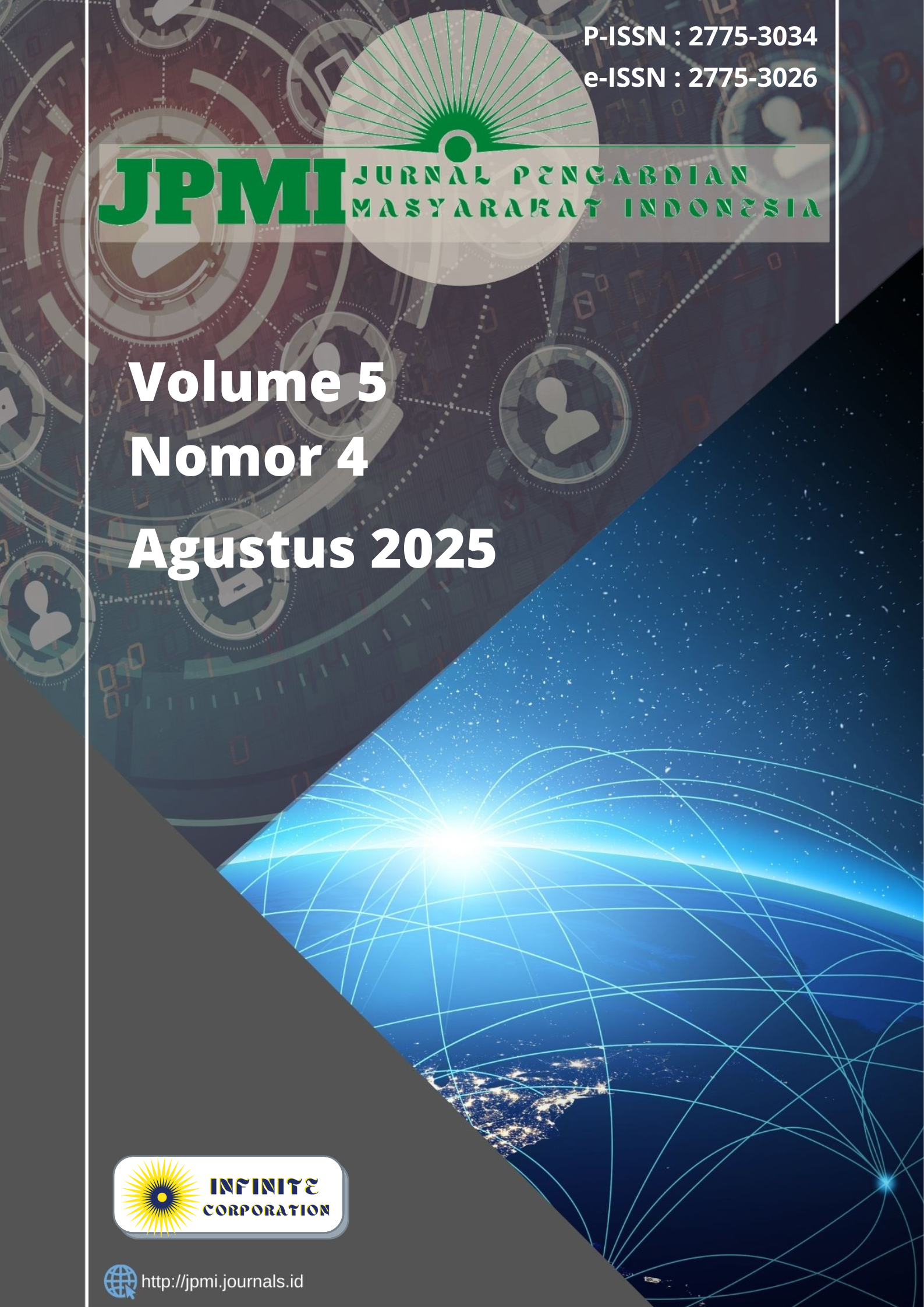Strategi Pembelajaran Diplomasi Siswa Muhammadiyah 10 Gresik Melalui Simulasi Sidang ASEAN
DOI:
https://doi.org/10.52436/1.jpmi.3701Keywords:
ASEAN, Daya Saing, Diplomasi, Negosiasi, PemudaAbstract
Program pengabdian masyarakat ini dirancang untuk meningkatkan keterampilan diplomasi dan negosiasi di kalangan pemuda, khususnya siswa SMA, dengan tujuan utama mengatasi rendahnya pengetahuan tentang diplomasi multilateral di Indonesia. Penelitian sebelumnya menyoroti bahwa pemuda Indonesia memiliki keterbatasan pengetahuan tentang cara kerja diplomasi di forum-forum multilateral dan minimnya pemahaman mengenai ASEAN. Kondisi ini menyebabkan Indonesia sering kali tidak optimal dalam memanfaatkan forum-forum multilateral dan isu-isu yang relevan bagi pemuda kurang diakomodasi. Untuk menanggulangi masalah ini, program ini menerapkan pendekatan pembelajaran berbasis aktivitas dan gamifikasi, yang memungkinkan siswa mempelajari konsep dan keterampilan melalui simulasi peran yang interaktif dan menyenangkan. Metode ini mencakup asesmen awal, seminar oleh pakar, dan simulasi sidang formal. Hasilnya menunjukkan peningkatan signifikan dalam aspek literasi siswa terhadap ASEAN, kemampuan menyusun argumentasi sebagai delegasi negara, pemahaman prosedur persidangan, keterampilan menjalankan sidang secara formal, dan kemampuan menyusun draf resolusi. Dampak dari kegiatan ini adalah peningkatan kesiapan dan daya saing pemuda Indonesia untuk berpartisipasi secara aktif dalam forum multilateral tingkat internasional, serta memberikan model yang dapat diterapkan di sekolah-sekolah lain.
Downloads
References
G. Sørensen, “What Kind of World Order?,” Coop Confl, vol. 41, no. 4, pp. 343–363, 2006, doi: 10.1177/0010836706069601.
C. Cannon and T. Biersteker, “The Governance of International Organisations: Structural Components, Internal Mechanisms, and Contemporary Challenges,” Advances in Corporate Governance: Comparative Perspectives, pp. 203–229, Oct. 2020, doi: 10.1093/OSO/9780198866367.003.0009.
T. Tarasenko, N. Sorokina, N. Kashchenko, T. Branitska, and I. Kukhar, “International collaboration in public governance: assessing the role of collective initiatives and organisations,” Multidisciplinary Science Journal, vol. 6, pp. 2024ss0715-2024ss0715, May 2024, doi: 10.31893/MULTISCIENCE.2024SS0715.
F. Anasti, “Tingkatkan Representatif di Organisasi Internasional, Ini Strategi Indonesia – Asosiasi Ilmu Hubungan Internasional Indonesia.” Accessed: Apr. 16, 2025. [Online]. Available: https://aihii.or.id/berita-aihii/tingkatkan-representatif-di-organisasi-internasional-ini-strategi-indonesia/#
R. Christha, “Dasar Hukum Politik Luar Negeri Bebas Aktif Indonesia | Klinik Hukumonline.” Accessed: Apr. 16, 2025. [Online]. Available: https://www.hukumonline.com/klinik/a/politik-luar-negeri-bebas-aktif-lt659d03593776f/#
B. Reinalda, The Ashgate Research Companion to Non-State Actors. Ashgate Publishing Ltd, 2011. Accessed: Apr. 16, 2025. [Online]. Available: https://www.routledge.com/The-Ashgate-Research-Companion-to-Non-State-Actors/Reinalda/p/book/9780754679066
N. Nasiritousi, M. Hjerpe, and K. Bäckstrand, “Normative arguments for non-state actor participation in international policymaking processes: Functionalism, neocorporatism or democratic pluralism?,” Eur J Int Relat, vol. 22, no. 4, pp. 920–943, Dec. 2016, doi: 10.1177/1354066115608926.
S. Cruz, A. Sharpe, and D. Young, “‘Our Future is Where the Heart is:’ How Futures Literacy Can Enhance Youth Voice and the Case of Youth Policy Development in Laos * Journal of Futures Studies,” Journal of Futures Studies, vol. 27, no. 1, pp. 129–141, 2022, Accessed: Apr. 16, 2025. [Online]. Available: https://jfsdigital.org/2022-2/vol-27-no-1-september-2022/our-future-is-where-the-heart-is-how-futures-literacy-can-enhance-youth-voice-and-the-case-of-youth-policy-development-in-laos/
G. Benny and K. Abdullah, “Indonesian Perceptions and Attitudes toward the ASEAN Community,” Journal of Current Southeast Asian Affairs, vol. 30, no. 1, pp. 39–67, Mar. 2011, doi: 10.1177/186810341103000102.
P. Rattanasevee, “Leadership in ASEAN: The Role of Indonesia Reconsidered,” Asian Journal of Political Science, vol. 22, no. 2, pp. 113–127, 2014, doi: 10.1080/02185377.2014.895912.
S. Kanchana, S. Patchainayagi, and S. Rajkumar, “EMPOWERING STUDENTS TO BECOME EFFECTIVE LEARNERS THROUGH ACTIVITY BASED LEARNING,” Humanities & Social Sciences Reviews, vol. 7, no. 5, pp. 57–62, Sep. 2019, doi: 10.18510/HSSR.2019.757.
R. Jahansyahtono, “Masyarakat Belum Paham soal MEA,” Kompas. Accessed: Apr. 16, 2025. [Online]. Available: https://money.kompas.com/read/2015/12/02/153900826/Masyarakat.Belum.Paham.soal.MEA
F. van Merode, A. Nieboer, H. Maarse, and H. Lieverdink, “Analyzing the dynamics in multilateral negotiations,” Soc Networks, vol. 26, no. 2, pp. 141–154, May 2004, doi: 10.1016/J.SOCNET.2004.01.006.
B. E. Wiggins, “An Overview and Study on the Use of Games, Simulations, and Gamification in Higher Education,” Journal of game-Based Learning, vol. 6, no. 1, pp. 18–29, Jan. 2016, doi: 10.4018/IJGBL.2016010102.
I. Zvarych, S. M. Kalaur, N. M. Prymachenko, I. V. Romashchenko, and O. I. Romanyshyna, “Gamification as a Tool for Stimulating the Educational Activity of Students of Higher Educational Institutions of Ukraine and the United States,” European Journal of Educational Research, vol. 8, no. 3, pp. 875–891, Jul. 2019, doi: 10.12973/EU-JER.8.3.875.
A. Sachpatzidis, G. F. Fragulis, and I. Antoniadis, “Gamification in the Vocational Schools of Greece,” AIP Conf Proc, vol. 2909, no. 1, Nov. 2023, doi: 10.1063/5.0182056/2924845.
G. R. Berridge, Diplomacy: Theory and Practice. Springer Science+Business Media, 2022. doi: 10.1007/978-3-030-85931-2/COVER.
Amitav. Acharya, Constructing a security community in Southeast Asia?: ASEAN and the problem of regional order. Routledge/Taylor & Francis Group, 2014. Accessed: Apr. 18, 2025. [Online]. Available: https://www.routledge.com/Constructing-a-Security-Community-in-Southeast-Asia-ASEAN-and-the-Problem-of-Regional-Order/Acharya/p/book/9780415747684
ASEAN Foundations, “Model ASEAN Meeting: A Guidebook Understanding ASEAN Processes and Mechanisms,” 2016, ASEAN Foundation, Jakarta.























